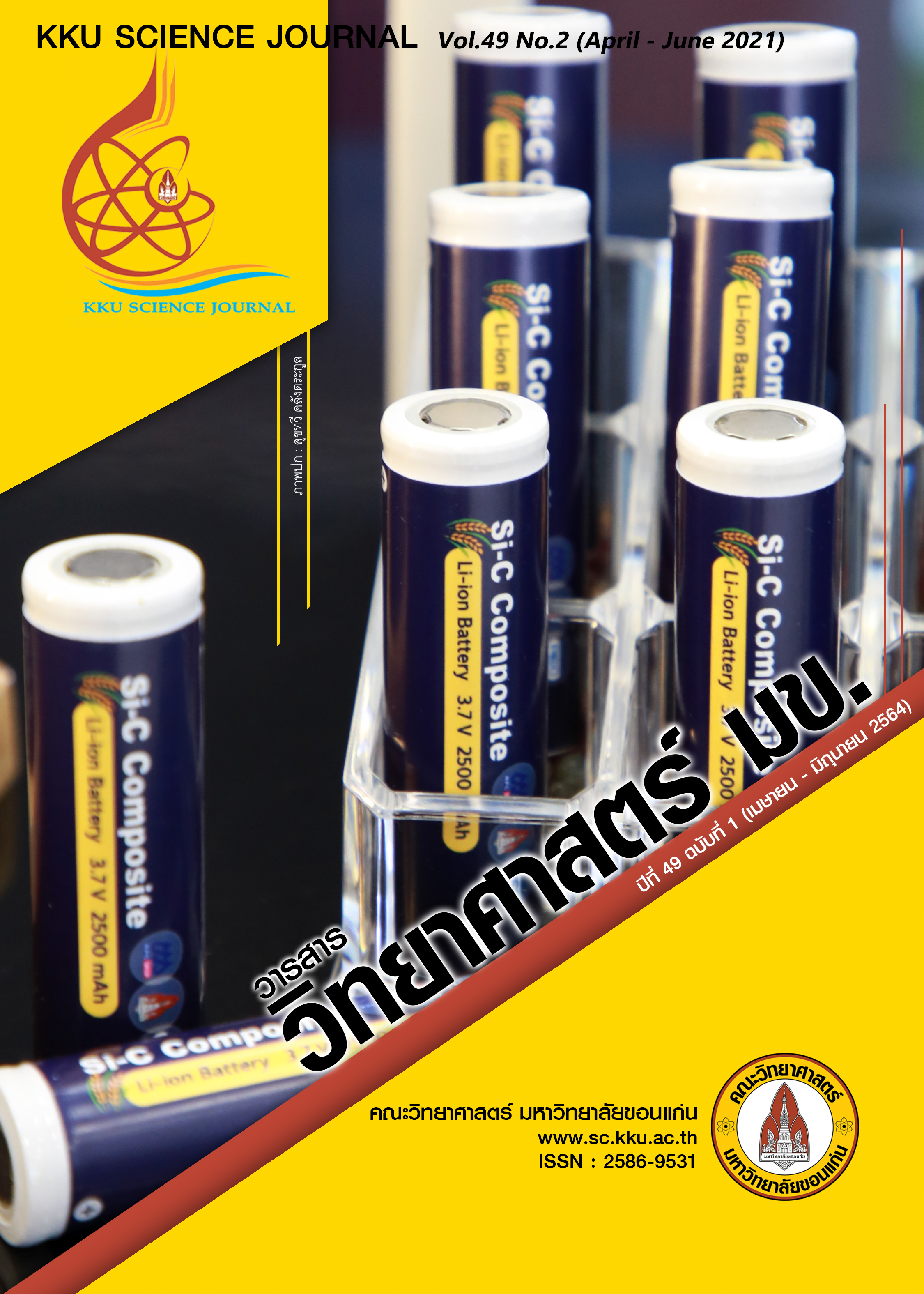Optimization of bioactive compounds extract from Clitoria ternatea Linn. by microwave-assisted extraction
Main Article Content
Abstract
Butterfly peas (Clitoria termatea Linn.) are contain anthocyanins that as antioxidant activity. The extracted from the butterfly peas were used as an ingredient or supplement in food products. Microwave- assisted (MWA) extraction was an effective extraction method that reduces extraction time and maintains antioxidant activity. The objective of this research was to select the appropriated conditions for the extraction of bioactive compounds extract from the butterfly. The three levels of MWA output power including 150, 450 and 750 W and three levels of extraction times including 3, 5 and 10 mins. Compare extraction methods between MWA, conventional (90°C, 2 hr.) and ultrasonic methods. The results were found that the microwave-assisted extraction at 150 W for 10 min had the highest of total phenolic content (44.27 ± 0.97 mg/100g) and antioxidant capacity by ABTS assay (77.88 ± 0.92 mg/100g) (p<0.05). The MWA at 750 W for 5 minutes found that the highest of % inhibition was 13.37 ± 0.34 by DPPH assay (p<0.05). The MWA extraction at 150 W could reduce extraction times 91.67% when comparing with the conventional extraction method. Therefore, MWA extraction at 150W for 10 min. was the optimal conditions and it was an alternative extraction method for potential butterfly peas extract.
Article Details

This work is licensed under a Creative Commons Attribution-NonCommercial-NoDerivatives 4.0 International License.
References
กาญจนา นาคประสม หยาดฝน ทนงการกิจ ภานาถ แสงเจริญรัตน์ และ นักรบ นาคประสม. (2562). การหาสภาวะที่เหมาะสมในการสกัดสารฟีนอลิกทั้งหมดจากเมล็ดลำไยโดยวิธีไมโครเวฟร่วม. วิทยาศาสตร์บูรพา 24(1): 48-63.
ดวงกมล เรือนงาม. (2557). การสกัดสารต้านอนุมูลอิสระ. วารสารวิทยาศาสตร์ลาดกระบัง 23(2): 120-139.
น้ำอ้อย บุญมาก และ บุณยกฤต รัตนพันธุ์. (2561). ผลของกำลังไฟฟ้าและเวลาต่อการสกัดสารต้านอนุมูลอิสระจากกากกาแฟโดยเครื่องไมโครเวฟ. รายงานการประชุมวิชาการระดับชาติ ครั้งที่ 5 มหาวิทยาลัยราชภัฏกำแพงเพชร. 674-679.
บุหรัน พันธุ์สวรรค์. (2556). อนุมูลอิสระ สารต้านอนุมูลอิสระ และการวิเคราะห์ฤทธิ์ต้านอนุมูลอิสระ. วารสารวิทยาศาสตร์และเทคโนโลยี 21(3): 275-286.
วีรยา ศักดิ์คำดวง นันทิยา วงศ์แสงตา และอรุณศรี ปรีเปรม. (2552). สารจากดอกอัญชัน: องค์ประกอบทางเคมีและฤทธิ์. วารสาร ศูนย์บริการวิชาการ มหาวิทยาลัยขอนแก่น 17(1-4): 10-15.
ศุกฤชชญา เหมะธุลิน สุภาพร โสภาจร และอินธิวา ศรีพันรมย์. (2558). ผลิตภัณฑ์เครื่องดื่มชนิดเข้มข้นเพื่อสุขภาพจากดอกไม่หลากสี. แก่นเกษตร 43(1): 305-310.
อารีรัตน์ ซื่อดี. (2560). การใช้คลื่นไมโครเวฟสกัดสารสำคัญจากพืชสมุนไพร. วารสารวิชาการมหาวิทยาลัยอีสเทิร์นเอเชีย: ฉบับวิทยาศาสตร์และเทคโนโลยี 11(1): 1-14.
เอนก หาลี และบุณยกฤต รัตนพันธุ์. (2560). การศึกษาประสิทธิภาพในการต้านอนุมูลอิสระจากพืชผักสมุนไพรพื้นบ้าน 15 ชนิด. วารสารวิจัยและพัฒนา มจธ. 40(2): 283 – 293.
AOAC. (2000). Official methods of analysis of AOAC. International 17th edition; Gaithersburg, MD, USA Association of Analytical Communities.
Boulekbache-Makhlouf, L., Medouni, L., Medouni-Adar, S., Arkoub, L. and Madani, K. (2013). Effect of solvents extraction on phenolics content and antioxidant activity of the byproduct of eggplant. Industrial Crops and Products 49: 668-674.
Came, V. (2000). Microwave-assisted solvent extraction of environmentral samples. TrAC Trends in Analytical Chemistry 19(4): 229-248.
Do, Q. D., Angkawijaya, A. E., Tran-Nguyen, P. L., Huynh, L. H., Soetaredjo, F. E., Ismadji, S. and Ju, Y. H. (2014). Effect of extraction solvent on total phenol content, total flavonoid content, and antioxidant activity of Limnophila aromatica. Journal of Food and Drug Analysis 22(3): 296-302.
Kazuma, K., Noda, N. and Suzuki, M. (2003). Flavonoid composition related to petal color in different lines of Clitoria ternatea. Phytochemistry 64(6): 1133-1139.
Makasana, J., Dholakiya, B. Z., Gajbhiye, N. A. and Raju, S.. (2017). Extractive determination of bioactive flavonoids from butterfly pea (Clitoria ternatea Linn.). Research on Chemical Intermediates 43(2): 783-799.
Mehmood, A., Ishaq, M., Zhao, L., Yaqoob, S., Safdar, B., Nadeem, M., Munir, M., Wang, C. (2019). Impact of ultrasound and conventional extraction techniques on bioactive compounds and biological activities of blue butterfly pea flower (Clitoria ternatea L.). Ultrasonics Sonochemistry 51: 12-19.
Muhammad Ezzudin, R. and Rabeta, M.S.. (2018). A potential of Telang tree (Clitoria ternatea) in human health. Journal of Food Science 2: 415-420.
Prommajak, T., Surawang, S., & Rattanapanone, N. (2014). Ultrasonic-assisted extraction of phenolic and antioxidative compounds from lizard tail (Houttuynia cordata Thunb.). Songklanakarin Journal of Science and Technology 36: 65-72.
Qin, C., Li, Y., Niu, W., Ding, Y., Zhang, R., Shang, X. (2010). Analysis and characterisation of anthocyanins in mulberry fruit. Czech Journal of Food Sciences 28(2): 117-126.
Routray, W. and Orsat, V. (2014). MAE of phenolic compounds from blueberry leaves and comparison with other extraction methods. Industrial Crops and Products 58: 36-45.
Sinha, K., Sah, PD., Ramya, V., Datta, S. (2012). Improved extraction of natural blue dye from butterfly pea using microwave assisted methodology to reduce the effect of synthetic blue dye. International Journal of Chemical Technology 4(2): 57-65.
Singh, K., Simapaisan, P. and Utama-ang, N. (2017). Effect of microwave-assisted extraction on curcuminoid from turmeric and application in germinate-coated rice. Food and Applied Bioscience Journal 5(1): 11-22.


